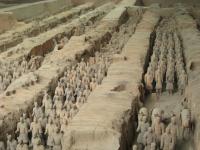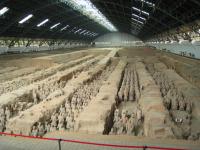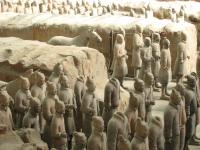The mosque might be great, but the reason you come to Xi’An is probably more because of the Army of Terracotta Warriors. I guess all people do so, if not here for business. Today I just let me drive around by a CITS guided tour to save all the hassle of finding the places far out Xi’An. It proved a good choice. The army is 1 hour’s drive out of Xi’An. But we startd very local…nearly…I was the first to get on the bus as the CITS main office is right next door. Then we did a sightseeing tour of Xi’An’s top class hotels and, belive it or not, one hour later drove by my hotel again on the way to the first stop. I could have slept an hour longer…grrr….
Big Wild Goose Pagoda (大雁塔)
This pagoda was built originally by the very famous monk Xuan Zang to store buddhist scriptures brought from India in AD 652. It was since rebuilt 2 storeys larger by a Chinese emporer by the name of GaoZong.
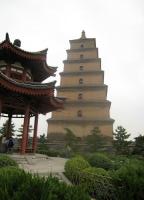
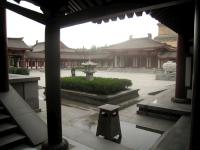
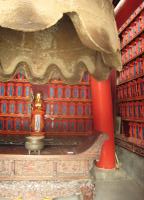
XA_20070620_100431.jpg: Looks actually OK from outside. To get inside you have to pay another stunning 20 RMB on top of the entrance fee (which was certainly covered by the CITS tour package), just to walk up seven flights of staircases through empty rooms…to get a bad hazy view on Xi’An. Do that only on a very clear day if the sight can reward you for the money and the efforts. There’s absolutely nothing in the pagoda to be seen.
XA_20070620_101052.jpg: The pagoda stands in a nice little temple, the Temple of Great Marternal Grace. That has some nice preserved courtyards, but unique they aren’t either.
XA_20070620_102641.jpg: The bell of the temple’s bell tower. Quite big a thing compared to its building.
Terracotta Warrior Factory
Yea…they are still produced…2000 years old…pffft, you can still get them as original as possible. So they claim at least.
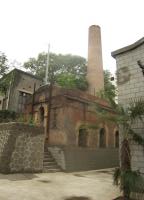
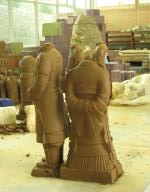
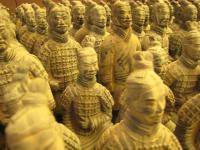
XA_20070620_105754.jpg: That’s the oven, in which the warriors are burned at about 1000°C for, if I remember correctly, 2 full weeks! Looks a bit tattered, but still seems to work out well given the output they are producing to flood the souvenir market.
XA_20070620_110127.jpg: Looks like chocolate, doesn’t it? 😉 But is actually wet clay. The factory claims to be the only one using the original clay from the tomb site, from which also the original terracotta warriors have been formed. Up to you to believe that (a) they are using this same clay at all and (b) are the only ones. But they make good money selling the story. They don’t hide the fact that they create body and head seperately. Seems to be necessary so that they don’t break or so during the process of burning.
XA_20070620_110735.jpg: My probably best Terracotta Army picture 😉 Unfortunately it can easily be identified as fake: The faces repeat while one of the features of the original army is that all facial expressions differ. In fact, this is a detailed picture of the 100cm souvenier warriors on sale.
Banpo Neolithic Village (半坡博物馆)
That site got very mixed reviews according to Lonely Planet. To be seen is the excavation site of a 6000 year old village. That means we are not talking about some remains like vase or bone fragments, but the actually site itself, covered nowadays under a huge roof to protect against the odds of weather. This way of showing an excavation site directly to the public was new to me. In Europe you might see a tiny bit as an example, but not a large pit. Here one third of the entire site was open to the public.
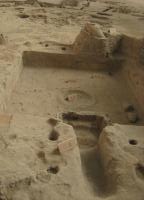
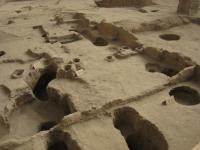
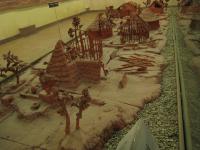
XA_20070620_113544.jpg: However, to be honest, there wasn’t much to see. All you get is an area of loam in which small round holes and larger rectangular holes are carved.
XA_20070620_114540.jpg: There is no way of saying how the archaeologists found these holes, i.e. how to unearth their secrets. Could be that just some kid digged a few holes some years ago. I’m not saying that I don’t trust the historical significance of this place. I am only saying it doesn’t become obvious to the visitor’s eyes.
XA_20070620_114849.jpg: A lot more interesting, in fact highly interesting at least to me, were some very good features about how these ancient people 6000 years ago actually did build their houses. Or how we think they did it… There were animated graphics shown on monitors, a small movie (of which I could only glimpse a few moments while the rest of the group looked at the inevitable bone fragments). The only thing that could be banned on SD chip was this small model of different house building stages. All is based on tree trunks being digged upright into earth in various ways. I found that quite smart.
Army of Terracotta Warriors (兵马俑)
After a lunch break at one of these inevitable tourist restaurants en route (food wasn’t so bad actually) we came to the highlight: The actual real army. By now I had understood from various sources that also this museum is also on the actual excavation site very similar to the Banpo Village. Or to be more exact: There are three pits to see, number 1 being the largest and most impressive, number 2 being also fairly large, but largely yet left alone, i.e. not yet unearthed. The over and over repeating reason given for not excavating the already known remainder of the warriors is that there is no technology yet known to preserve the colors with which the original warriors had been painted. All we see nowadays is these grey figures below. The color is visible directly after unearthing the pieces, but vanishes in a matter of hours at air and light. Only if a preservation method is known excavations shall continue. True reason or not…only one third of pit 1 is excavated and nearly nothing of the other two.
XA_20070620_135239.jpg: That’s it: The Terracotta Warrior Army of the first Chinese emporer (whose name I have to look up…eh…)
XA_20070620_135356.jpg: What we see here under a huge roof is actually not exactly perfectly original. Yesterday I came across an extremely negative blog article of somebody claiming to have studied Chinese and having spent several years in China, coming into Xi’An after 2 weeks of silk road travel, and was harshly criticising the obvious fool’s play done to the tourist here: The warriors, so (s)he wrote, can’t be real. No 2000 year old treaure would be kept so much exposed to the public. They anyway look way too good and (s)he never felt to be treated so badly. Ending the article not to be able to comment on Xi’An’s food and nightlife as (s)he had only eaten at McD and Pizza Hut. Hm…very questinable blog article, but in fact I was similarly wondering how this is supposed to work out. But there can be no doubt that the fired clay, becoming the material we nowadays refer to as ‘terracotta’, is exdtremely resistable.
XA_20070620_135552.jpg: The warriors we see, however, have been put together again by archaeologists. It is perfectly understood that they have not survived without damage. I raised all the above questions to our tour guide and her answer was that certainly all parts shown here are original pieces put together again. A large puzzle, every warrior takes several months to reconstruct from the bits and pieces found. If a part cannot be found then it would be left missing in the displayed figure.
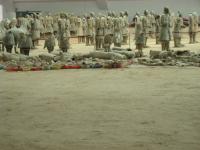
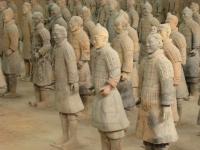
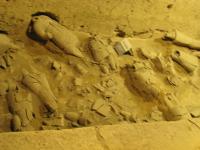
XA_20070620_140233.jpg: As a matter of historical fact: The site survived only a few years untouched. At the end of the China-founding Qin dynasty the new rulers smashed the warriors to pieces, took away many of the original bronze weapons the warriors had carried, and burned down the entire tomb, which the warriors were supposed to guard. Found today are nearly only individual pieces. This picture shows what the guide so nicely named “Terracotta Warrior Hospital”: Pieces are lying aound and nearly finished warriors are standing there, waiting to be finished…
XA_20070620_140927.jpg: …to look again as good as their comrades in arms.
XA_20070620_142914.jpg: This picture from pit 2 gives you an idea how much work there was for the archaeologists: Some smashed pieces still left in the earth.
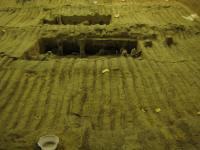
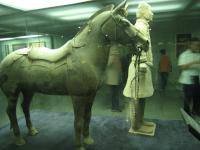
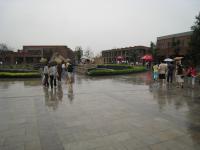
XA_20070620_144802.jpg: And this one from the large pit 3 shows how much work there still is waiting ahead. All you can see here is the wodden roof of the chamber. Under the roof hundreds of warriors still wait to be excavated as soon as color protection procedure become available. Or whatever the real reason is…
XA_20070620_145122.jpg: 3 very well preserved examples where under glass on display, maybe also as an encouragement to the archaelogists working on the site… 😉
XA_20070620_161055.jpg: The all day high humidity had turned into outright rain during our visit to the Terracotta Army Museum. Actually a very good use of such bad a day. That’s why this picture of the surroundings of the exit of the museum is so mirroring. You need to walk 15 minutes past modern newly built shops of warriors over warriors, the above picture shows about one fourth of the way…I haven’t checked if all the figures on sale are made from the very official clay reserved only for this one factory above…actually, turnover was very low for the shops anyway. People just wanted to get out of the rain into their busses. And it wasn’t busy anyway. But our guide told us horror stories about what the area looks like on May and National holidays…I got an idea on other travel occasions and definitely can live without that experience here.
Today’s Lesson: Chinese culture is very old indeed.
Categories: AsiaXi’An
Originally Created: 06/20/2007 02:00:35 PM
Last Edited: 06/20/2007
